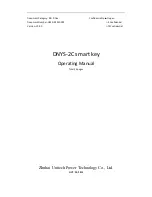
895UM0001_02
DU100 User Manual
Page 16 of 19
5.3 Detection Sensitivity
Detection sensitivity may be defined as the threshold level at which the smallest
change in inductance results in an output actuation. This is clearly dependent on the
inductive loop characteristics and may be adjusted by the sensitivity switch setting on
the detector itself.
With the detector set to maximum sensitivity, relatively smaller changes in inductance
result in detection. Detector sensitivity settings are designed such that maximum
sensitivity should be capable of detecting all vehicles while lower settings would
eliminate detection of bicycles, supermarket trolleys, and the over hang of high bed
vehicles.
Maximum and minimum values ( as shown in the DU100 sensitivity menu )
correspond to the largest and smallest changes in inductance resulting in detection
since the last time the detector was reset ( manual or power reset ).
The desired level of sensitivity may be achieved by comparison between recorded
changes and sensitivity switch settings at a particular site.
Over a process of time, the minimum value which will approach the demanded
sensitivity threshold of the detector, thus confirming this selection.
To reliably determine which sensitivity level should be used at any particular site, the
sensitivity level of the detector should be set to maximum ( to ensure that all vehicles
are detected ). A variety of vehicles matching the types used on the site should be
driven over the loop to determine the level of change. The vehicle with the lowest
change ( on the “MAX” level of the DU100 sensitivity menu ) should be used to then
determine the sensitivity threshold of the detector. A threshold more sensitive than the
observed change should be selected.
If a particular vehicle was to be excluded (e.g. supermarket trolley ) then the threshold
level selected on the detector would be less sensitive than the maximum change
recorded for the vehicle.
5.4 Detector Status
Detector status may be defined as the current state the detector is operating in when
the Diagnostic Unit takes the samples.
The first event that will occur after the detector is powered or a loop is connected
( and the Diagnostic Unit is receiving data ) is that the detector will begin to tune
( Tuning ). During this time the detector will determine the operating frequency of the
loop connected and most suitable operating parameters to be applied to the loop.




































